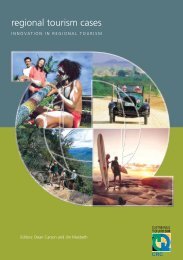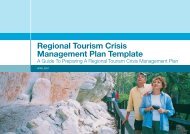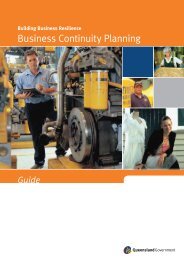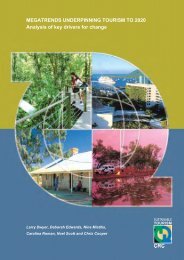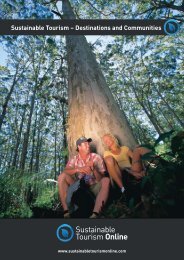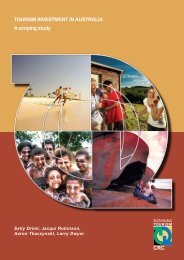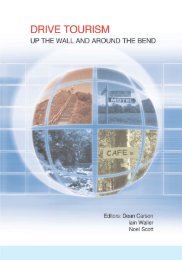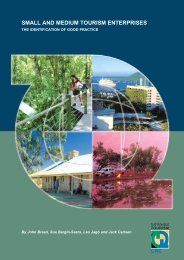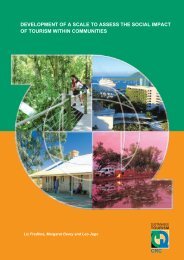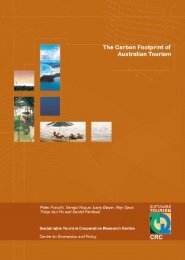Tourism Risk Management - Sustainable Tourism Online
Tourism Risk Management - Sustainable Tourism Online
Tourism Risk Management - Sustainable Tourism Online
You also want an ePaper? Increase the reach of your titles
YUMPU automatically turns print PDFs into web optimized ePapers that Google loves.
crisis in the relatively short history of international tourism. Asia-Pacific destinations suffered a<br />
decline of more that 14 million visitor arrivals in the first six months of 2003.<br />
Project Phoenix<br />
The SARS crisis demanded a strong and effective response to combat the fears of global travellers.<br />
On behalf of the industry, PATA created Project Phoenix, a bold initiative to restore consumer and<br />
business confidence in travel to and within the Asia-Pacific region.<br />
PATA appointed a leading public relations company and tourism communications expert to manage<br />
Phoenix which was essentially a communications program to deliver positive images and messages<br />
about the region through TV, print and online media. The end result far surpassed expectations with<br />
Phoenix achieving high levels of consumer response in less than four months. It had three specific<br />
purposes, to:<br />
1. restore consumer confidence in the travel experience;<br />
2. create a consistent single voice for travel and tourism in Pacific Asia; and<br />
3. drive business back to Pacific Asia destinations.<br />
TV Campaigns<br />
Phoenix faced two major communication challenges: first, to persuade scared, sceptical travellers<br />
that it was time to put Asia-Pacific back on their list of travel destinations; second, to gain as much<br />
‘free ink’ as possible by leveraging its relationship with global media companies and creative<br />
publications. It succeeded on both counts. A great example was the ‘Welcome Back’ campaign on<br />
CNN, with US$1 million of airtime, reaching 130 million global households and a TV commercial<br />
that tapped into the hearts of travellers everywhere. Phoenix created campaigns with BBC World<br />
and the National Geographic Channel as well as producing its own SMILES campaign.<br />
Print Ads<br />
As part of the ‘Welcome Back’ campaign, two print ads were rotated in TIME magazine, (US and<br />
International editions) and Fortune magazine, (Europe and Asia editions). Phoenix also produced<br />
print ads as part of the SMILES campaign, one aimed at consumers, the other at trade. Both<br />
provided acknowledgement and brand exposure for Phoenix contributors. These ads were<br />
supported by National Geographic Traveler Magazine, Newsweek, Travel Trade Gazette (TTG<br />
Asia), Travel Weekly, Travel Trade Report and the STS Times.<br />
Publicity<br />
PATA had two basic objectives with its publicity drive. One was to achieve as much positive<br />
coverage as possible, through the efforts of Phoenix and MDK consultants. The other was to use<br />
Phoenix to build PATA’s public profile, to demonstrate to members and the industry at large that<br />
PATA was vigorously embracing its new strategic mandate to be a vocal advocate on the key<br />
issues impacting the region. Phoenix succeeded in generating positive media coverage in<br />
consumer and trade publications in excess of US$2 million.<br />
Promotions<br />
Another Phoenix strategy was to harness the creative energy and support of the 70 PATA Chapters<br />
around the world. In the United States for instance, there are 20 Chapters with more than 3,000<br />
individual members. PATA’s regional office in Europe, Americas and Pacific worked closely with the<br />
Chapters to spread positive messages about Asia-Pacific and restore confidence in travel to the<br />
region.<br />
40 <strong>Tourism</strong> <strong>Risk</strong> <strong>Management</strong> – An Authoritative Guide to Managing Crises in <strong>Tourism</strong>



